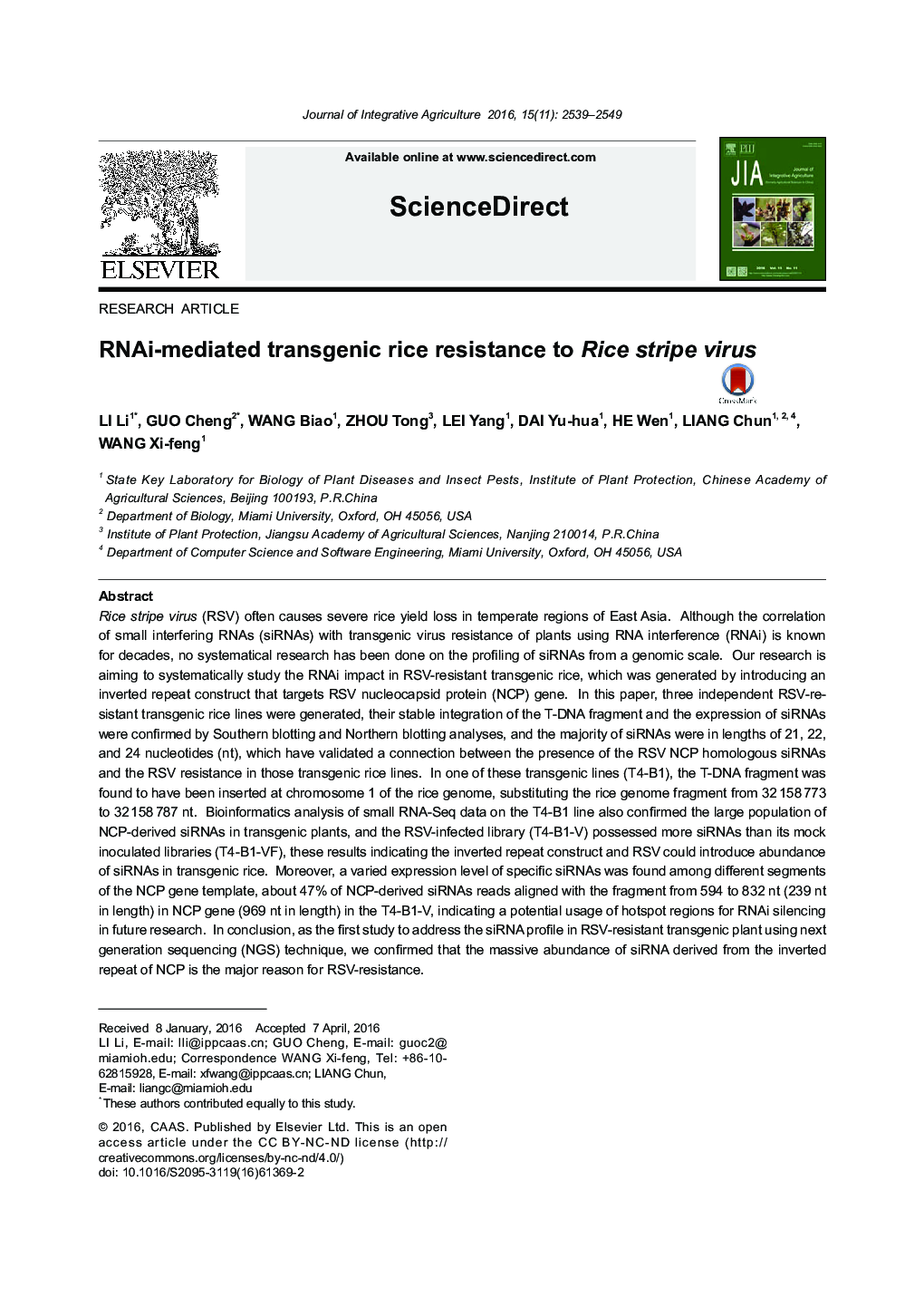| کد مقاله | کد نشریه | سال انتشار | مقاله انگلیسی | نسخه تمام متن |
|---|---|---|---|---|
| 8876211 | 1623715 | 2016 | 11 صفحه PDF | دانلود رایگان |
عنوان انگلیسی مقاله ISI
RNAi-mediated transgenic rice resistance to Rice stripe virus
دانلود مقاله + سفارش ترجمه
دانلود مقاله ISI انگلیسی
رایگان برای ایرانیان
کلمات کلیدی
موضوعات مرتبط
علوم زیستی و بیوفناوری
علوم کشاورزی و بیولوژیک
علوم کشاورزی و بیولوژیک (عمومی)
پیش نمایش صفحه اول مقاله

چکیده انگلیسی
Rice stripe virus (RSV) often causes severe rice yield loss in temperate regions of East Asia. Although the correlation of small interfering RNAs (siRNAs) with transgenic virus resistance of plants using RNA interference (RNAi) is known for decades, no systematical research has been done on the profiling of siRNAs from a genomic scale. Our research is aiming to systematically study the RNAi impact in RSV-resistant transgenic rice, which was generated by introducing an inverted repeat construct that targets RSV nucleocapsid protein (NCP) gene. In this paper, three independent RSV-re-sistant transgenic rice lines were generated, their stable integration of the T-DNA fragment and the expression of siRNAs were confirmed by Southern blotting and Northern blotting analyses, and the majority of siRNAs were in lengths of 21, 22, and 24 nucleotides (nt), which have validated a connection between the presence of the RSV NCP homologous siRNAs and the RSV resistance in those transgenic rice lines. In one of these transgenic lines (T4-B1), the T-DNA fragment was found to have been inserted at chromosome 1 of the rice genome, substituting the rice genome fragment from 32 158 773 to 32 158 787 nt. Bioinformatics analysis of small RNA-Seq data on the T4-B1 line also confirmed the large population of NCP-derived siRNAs in transgenic plants, and the RSV-infected library (T4-B1-V) possessed more siRNAs than its mock inoculated libraries (T4-B1-VF), these results indicating the inverted repeat construct and RSV could introduce abundance of siRNAs in transgenic rice. Moreover, a varied expression level of specific siRNAs was found among different segments of the NCP gene template, about 47% of NCP-derived siRNAs reads aligned with the fragment from 594 to 832 nt (239 nt in length) in NCP gene (969 nt in length) in the T4-B1-V, indicating a potential usage of hotspot regions for RNAi silencing in future research. In conclusion, as the first study to address the siRNA profile in RSV-resistant transgenic plant using next generation sequencing (NGS) technique, we confirmed that the massive abundance of siRNA derived from the inverted repeat of NCP is the major reason for RSV-resistance.
ناشر
Database: Elsevier - ScienceDirect (ساینس دایرکت)
Journal: Journal of Integrative Agriculture - Volume 15, Issue 11, November 2016, Pages 2539-2549
Journal: Journal of Integrative Agriculture - Volume 15, Issue 11, November 2016, Pages 2539-2549
نویسندگان
Li LI, Cheng GUO, Biao WANG, Tong ZHOU, Yang LEI, Yu-hua DAI, Wen HE, Chun LIANG, Xi-feng WANG,